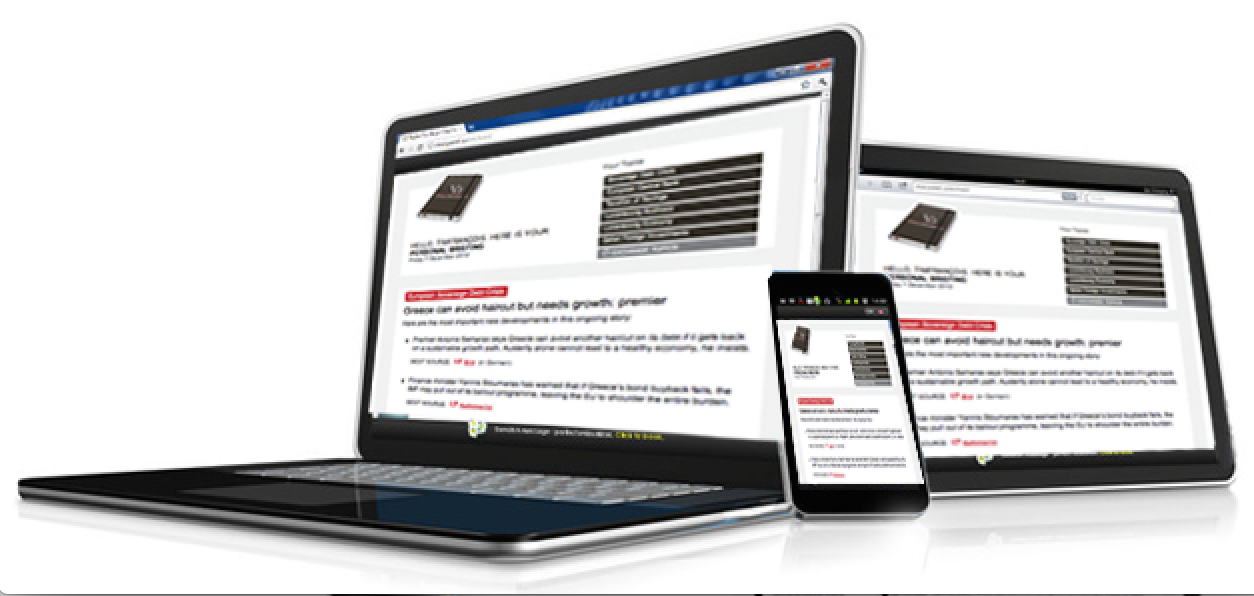
VitalBriefing email newsletters adapt perfectly to any device and screen size, critical to maximum readability
I’m reading Gleick’s magisterial survey, The Information, instead of chewing off my fingernails as I usually do in the dog days of summer when everyone else heads to the beach.
I swear that his use of “vital” had no bearing on our choice of company name. But it certainly does now.
Although cutting-edge technology is a key component of how we create our vital information, we’ve chosen the Internet’s equivalent of the Gutenberg Press as the channel for delivering the “blood and the fuel” to our clients.
I’m referring to that timeless workhorse, the email newsletter, a format the late New York Times columnist David Carr referred to as “an old-school artefact of the web that was supposed to die along with dial-up connections.”
Yet, that was just the first half of his thought, concluding that the artefacts “are not only still around, but very much on the march.”
I’ve always had a healthy respect for newsletters, possibly because they’ve been a consistent feature of my career. In fact, my relationship with the format goes back to my early life as a journalist about a million years ago.
One of my first jobs out of university was as a reporter on a coal industry newsletter in Washington, D.C. The six-page weekly report, printed on orange paper and sent via snail mail (the U.S. Postal Service), had a highly appreciative industry audience that hung on its every issue. We routinely scooped major media because we were so highly focused on our niche area, subject-expert journalists digging deep to unearth and explore the most important and behind-the-scenes developments in the industry.
Years later, the first digital media company I founded, in Silicon Valley, specialized in creating and producing email newsletters for media clients that were highly valued by millions of their subscribers.
I wasn’t surprised, then, when all our initial product testing for VitalBriefing found that the most efficient and valued way to deliver essential, must-have business intelligence to the financial industry, or indeed to any industry, was via — wait for it — email newsletters.
In this era of information overload, it’s interesting how people respond to the idea of email newsletters. We’re used to hearing this from prospective clients: “Oh, I get a million email newsletters and trash them. But there’s this one that gives me exactly what I’m looking for…”
So when we decided to use newsletters as our main channel, our goal was easy to define: We want to be that one.
We consistently test this with our clients, and what we hear over and over again is just that: “I open my VitalBriefing newsletter first thing.” And it’s gratifying to see that this many years later, the best, most relevant and timely newsletters continue to cut through the noise as a valued means of conveying curated information.
It makes sense. We combine advanced search technology and subject-expert curation to create concise, targeted summaries that our clients need to see quickly, efficiently and in a format they can quickly absorb.
Newsletters, well designed and adjusting automatically to any size screen or device, offer a perfectly organized “wrapping” for that kind of content.
“Newsletters are clicking because readers have grown tired of the endless stream of information on the Internet, and having something finite and recognizable show up in your inbox can impose order on all that chaos,” Carr wrote.
A study by Quartz, a digital news site that sends highly popular general news newsletters surveyed 940 global executives and found that email newsletters were more valued than the Internet and mobile apps as a source for news. Key findings:
- 44% of executives are more focused on news when they wake up (That’s why VitalBriefing’s newsletters are delivered at 6 a.m.).
- 77% of finance industry executives spend a minimum 30 minutes a day consuming news and 44% spend a minimum 60 minutes. (Our business intelligence newsletters keep clients on top of everything they need to know).
- 60% read an email newsletter as one of their first three news sources each day, and 54% of finance executives include email newsletters among their top three sources for news about their industry (which explains why they continue to tell us they prefer email newsletters as our mainproduct).
- 47% finance executives pay for digital news. (They understand that the best, most valuable content about specific industries has a cost. They pay us to monitor their brand reputation, their competitors and clients, key industry developments – and they pay us for the quality of the subject-specific journalism backing the information.)
Quartz’s conclusion? “In the past few years,” says Gideon Lichfield of Quartz, “we have started to see email as a peer to publishing platforms like Twitter, Facebook and the web.”
Despite the shift of attention to social media, and to the “next next thing,” all the signs continue to point to the email newsletter, that relic of the Internet’s early days, as still the single best vehicle for shipping the blood and fuel to our clients.

